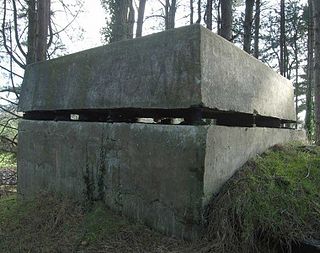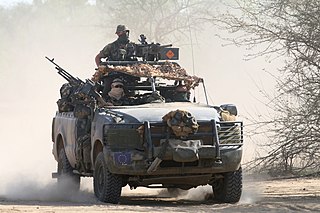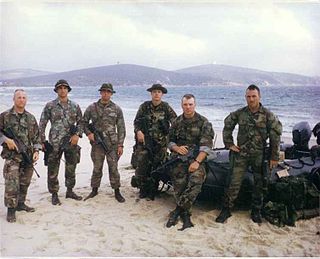 W
WIn military operations, reconnaissance or scouting is the exploration outside an area occupied by friendly forces to gain information about natural features and other activities in the area.
 W
WAmphibious reconnaissance is ground and naval reconnaissance in the littoral area bordering coastal or ocean areas. Initially, it is used for preliminary reconnaissance in collecting pertinent information about the beachhead in its permeability and usability for main landing assaults. Specialized recon patrols skilled in boatswain and combatant diving using either amphibious vehicles or rubber crafts to obtain and collect information on the enemy, the topology ashore and inland, and hydrographic surveys for underwater obstacles and mines, and for the purpose of affecting a deception.
 W
WAn Apache scout is a member of an Apache tribe who is trained in reconnaissance, either for hunting, defense of the people, or during times of war.
 W
WArmoured reconnaissance or armoured scouting is the combination of terrestrial reconnaissance with armoured warfare by soldiers using wheeled or tracked armoured reconnaissance vehicles. Armoured scouts are armed and armoured more heavily than ordinary scouting vehicles. While the mission of reconnaissance is to gather intelligence about the enemy with the use of reconnaissance vehicles, armoured reconnaissance adds the ability to fight for information, and to have an effect on and to shape the enemy through the performance of traditional armoured tasks.
 W
WThe Fizir F1V was the basis from which engineer Rudolf Fizir developed a series of single-engined, two-seat, reconnaissance biplanes fitted with different engines. Construction was carried out in the Yugoslav aircraft factories Zmaj and Rogožarski between 1928 and 1932.
 W
WISTAR stands for intelligence, surveillance, target acquisition, and reconnaissance. In its macroscopic sense, ISTAR is a practice that links several battlefield functions together to assist a combat force in employing its sensors and managing the information they gather.
 W
WAn observation post, temporary or fixed, is a position from which soldiers can watch enemy movements, to warn of approaching soldiers, or to direct artillery fire. In strict military terminology, an observation post is any preselected position from which observations are to be made - this may include very temporary installations such as a vehicle parked as a roadside checkpoint, or even an airborne aircraft.
 W
WA patrol is commonly a group of personnel, such as law enforcement officers, military personnel, or private security contractors that are assigned to monitor a specific geographic area.
 W
WPatrolling is a military tactic. Small groups or individual units are deployed from a larger formation to achieve a specific objective and then return. The tactic of patrolling may be applied to ground troops, armored units, naval units, and combat aircraft. The duration of a patrol will vary from a few hours to several weeks depending on the nature of the objective and the type of units involved.
 W
WThe Radio Reconnaissance Platoon is a specially trained element of a United States Marine Corps Radio Battalion. A Radio Reconnaissance Team (RRT) was assigned as the tactical signals intelligence collection element for the Marine Corps Special Operations Command, Detachment One. Regular RRTs also participate in SOC operations during Marine Expeditionary Unit, or MEU(SOC), deployments.
 W
WSpecial reconnaissance (SR) is conducted by small units of highly trained military personnel, usually from special forces units or military intelligence organizations, who operate behind enemy lines, avoiding direct combat and detection by the enemy. As a role, SR is distinct from commando operations, but both are often carried out by the same units. The SR role frequently includes covert direction of air and missile attacks, in areas deep behind enemy lines, placement of remotely monitored sensors, and preparations for other special forces. Like other special forces, SR units may also carry out direct action and unconventional warfare, including guerrilla operations.
 W
WThe United States armed forces classify reconnaissance missions as "close" or "short-range"; "distant" or "medium-range"; and "deep" or "long-range".
 W
WA reconnaissance vehicle, also known as a scout vehicle, is a military vehicle used for forward reconnaissance. Both tracked and wheeled reconnaissance vehicles are in service. In some nations, light tanks such as the M551 Sheridan and AMX-13 have also been used by scout platoons. Reconnaissance vehicles are usually designed with a low profile or small size and are lightly armoured, relying on speed and cover to escape detection. Their armament ranges from a medium machine gun to a large cannon. Modern examples are often fitted with ATGMs and a wide range of sensors.